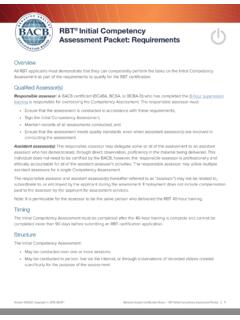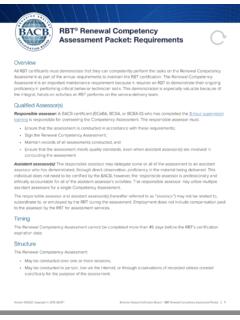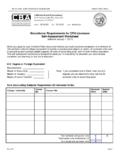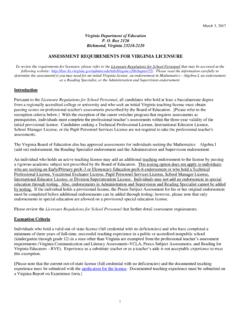Transcription of NIST MEP Cybersecurity Self-Assessment Handbook For ...
1 NIST Handbook 162 NIST MEP Cybersecurity Self-Assessment Handbook For Assessing NIST SP 800-171 Security requirements in Response to DFARS Cybersecurity requirements Patricia Toth This publication is available free of charge from: NIST Handbook 162 NIST MEP Cybersecurity Self-Assessment Handbook For Assessing NIST SP 800-171 Security requirements in Response to DFARS Cybersecurity requirements Patricia Toth Programs and Partnerships Division Manufacturing Extension Partnership This publication is available free of charge from: November 2017 Department of Commerce Wilbur L. Ross, Jr., Secretary National Institute of Standards and Technology Walter Copan, NIST Director and Undersecretary of Commerce for Standards and Technology i This publication is available free of charge from: Abstract The Handbook is intended to be a guide to assist manufacturers who supply products within supply chains for the DOD and who must ensure adequate security by implementing NIST SP 800-171 as part of the process for ensuring compliance with DFARS clause , Safeguarding Covered Defense Information and Cyber Incident Reporting, available at # Key words assessment ; compliance; Controlled Unclassified Information; CUI; Cybersecurity ; DFARS; DOD supply chain; information security; manufacturing; MEP; small manufacturer.
2 Self-Assessment ; SP 800-171. ii This publication is available free of charge from: Table of Contents Disclaimer .. viii Acknowledgements .. viii About NIST MEP and the MEP National Network .. viii Introduction .. 1 Role of NIST in SP 800-171 .. 1 What is NIST SP 800-171 and how does a manufacturer implement it? .. 2 Using this Handbook to Conduct an assessment .. 4 Preparation .. 4 assessment Results .. 6 Self-Assessment Handbook .. 7 Access Control: SP 800-171 Security Family .. 7 Limit system access to authorized users, processes acting on behalf of authorized users, or devices (including other systems).. 8 Limit system access to the types of transactions and functions that authorized users are permitted to execute.. 9 Control the flow of CUI in accordance with approved authorizations.
3 10 Separate the duties of individuals to reduce the risk of malevolent activity without collusion.. 11 Employ the principle of least privilege, including for specific security functions and privileged accounts.. 12 Use non-privileged accounts or roles when accessing non-security functions.. 13 Prevent non-privileged users from executing privileged functions and audit the execution of such functions.. 14 Limit unsuccessful logon attempts.. 15 Provide privacy and security notices consistent with applicable CUI rules.. 16 Use session lock with pattern-hiding displays to prevent access/viewing of data after period of inactivity.. 17 Terminate (automatically) a user session after a defined 18 Monitor and control remote access sessions.
4 19 Employ cryptographic mechanisms to protect the confidentiality of remote access sessions.. 20 Route remote access via managed access control points.. 21 Authorize remote execution of privileged commands and remote access to security-relevant information.. 22 Authorize wireless access prior to allowing such connections.. 23 iii This publication is available free of charge from: Protect wireless access using authentication and encryption.. 24 Control connection of mobile devices.. 25 Encrypt CUI on mobile devices.. 26 Verify and control/limit connections to and use of external information Limit use of organization portable storage devices on external information systems. 28 Control CUI posted or processed on publicly accessible information systems.
5 29 Awareness and Training: SP 800-171 Security Family .. 30 Ensure that managers, systems administrators, and users of organization information systems are made aware of the security risks associated with their activities and of the applicable policies, standards, and procedures related to the security of organization information systems.. 31 Ensure that organization personnel are adequately trained to carry out their assigned information security-related duties and responsibilities.. 32 Provide security awareness training on recognizing and reporting potential indicators of insider threat.. 33 Audit and Accountability: SP 800-171 Security Family .. 34 Create, protect, and retain information system audit records to the extent needed to enable the monitoring, analysis, investigation, and reporting of unlawful, unauthorized, or inappropriate information system activity.
6 35 Ensure that the actions of individual information system users can be uniquely traced to those users so they can be held accountable for their actions.. 36 Review and update audited events.. 37 Alert in the event of an audit process failure.. 38 Correlate audit review, analysis, and reporting processes for investigation and response to indications of inappropriate, suspicious, or unusual activity.. 39 Provide audit reduction and report generation to support on-demand analysis and reporting.. 40 Provide an information system capability that compares and synchronizes internal system clocks with an authoritative source to generate time stamps for audit records.. 41 Protect audit information and audit tools from unauthorized access, modification, and deletion.
7 42 Limit management of audit functionality to a subset of privileged users.. 43 Configuration Management: SP 800-171 Security Family .. 44 Establish and maintain baseline configurations and inventories of organization information systems (including hardware, software, firmware, and documentation) throughout the respective system development life cycles.. 45 iv This publication is available free of charge from: Establish and enforce security configuration settings for information technology products employed in organization information systems.. 47 Track, review, approve/disapprove, and audit changes to information systems.. 48 Analyze the security impact of changes prior to implementation.. 49 Define, document, approve, and enforce physical and logical access restrictions associated with changes to the information system.
8 50 Employ the principle of least functionality by configuring the information system to provide only essential capabilities.. 51 Restrict, disable, and prevent the use of nonessential programs, functions, ports, protocols, and services.. 52 Apply deny-by-exception (blacklist) policy to prevent the use of unauthorized software or deny-all, permit-by-exception (whitelisting policy to allow the execution of authorized software.. 53 Control and monitor user-installed software.. 55 Identification and Authentication: SP 800-171 Security Family .. 56 Identify information system users, processes acting on behalf of users, or Authenticate (or verify) the identities of those users, processes, or devices, as a prerequisite to allowing access to company information systems.)
9 58 Use multifactor authentication for local and network access to privileged accounts and for network access to non-privileged accounts.. 59 Employ replay-resistant authentication mechanisms for network access to privileged and non-privileged accounts.. 61 Prevent reuse of identifiers for a defined period.. 62 Disable identifiers after a defined period of inactivity.. 63 Enforce a minimum password complexity and change of characters when new passwords are created.. 64 Prohibit password reuse for a specified number of generations.. 65 Allow temporary password use for system logons with an immediate change to a permanent 66 Store and transmit only encrypted representation of passwords.. 67 Obscure feedback of authentication information.
10 68 Incident Response: SP 800-171 Security Family .. 69 Establish an operational incident-handling capability for organizational information systems that includes adequate preparation, detection, analysis, containment, recovery, and user response activities.. 70 Track, document, and report incidents to appropriate officials and/or authorities both internal and external to the organization.. 71 Test the organization incident response capability.. 73 v This publication is available free of charge from: Maintenance: SP 800-171 Security Family .. 74 Perform maintenance on organization information systems.. 75 Provide effective controls on the tools, techniques, mechanisms, and personnel used to conduct information system maintenance.














